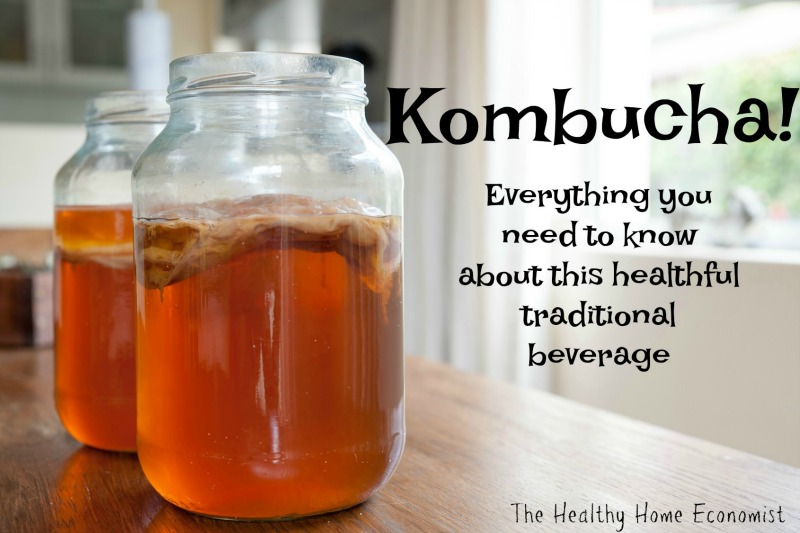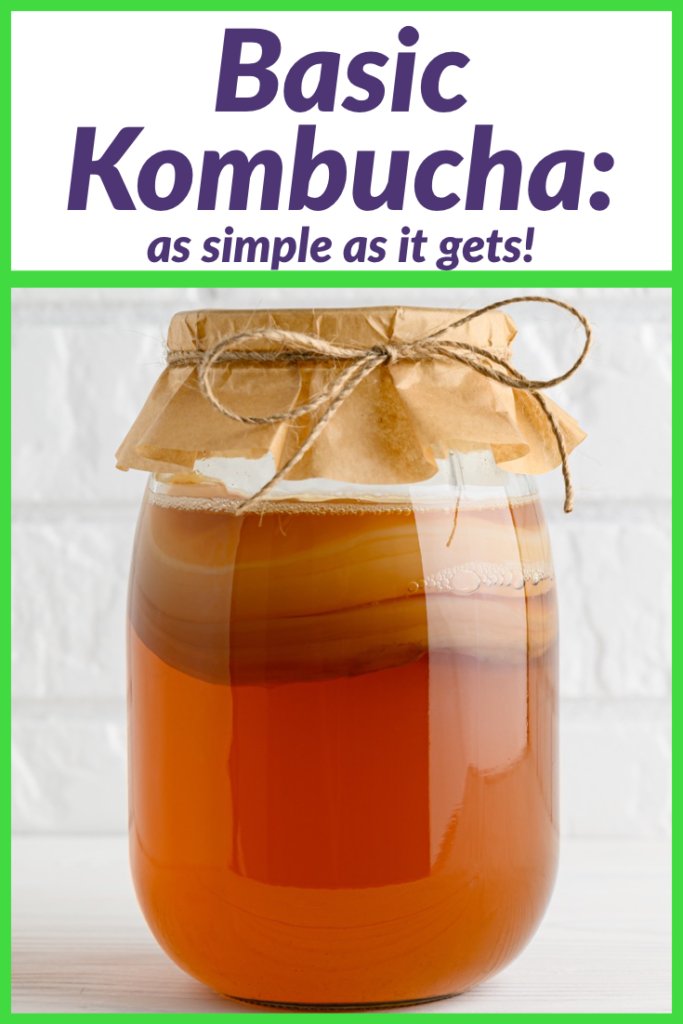Table of Contents[Hide][Show]
Easiest method to make kombucha at home in order to enjoy this delicious, traditional beverage without resorting to commercial versions that can be improperly fermented or high in sugar and fluoride.

Kombucha is arguably one of the hottest beverage trends to sweep the world in recent years. The discussion, recipe, and video demonstrations below provide all the information you need to understand kombucha benefits to health and how to make this tasty probiotic beverage in your home.
The traditional probiotic drink made from fermented tea originated in China and then Russia. It is made with black, green, or white tea and cane sugar. Kombucha has a colorful history. Ancestral cultures enjoyed it for many centuries before it was “rediscovered” in the 1990s in the United States. In China, kombucha resembled Jun tea, using green tea and honey. In Russia, fermented tea used black tea and cane sugar.
Extensive testing in Russia many decades ago proved it to be an effective overall body detoxifier. This occurs through the binding of the organic acids in the beverage to all manner of toxins present in the body. Once tightly bound to the organic acids, the toxins are rushed to the kidneys for excretion.
Russian communities that drink a lot of fermented tea do not suffer from the cancer epidemics that plague folks who live near that country’s toxin spewing factories — even when the local flora and fauna are dying!
The Soviet Union before the fall of the Iron Curtain used kombucha as one of its secret weapons in the development of its Olympic athletes. While training, athletes would drink up to 1 quart of kombucha per day to prevent lactic acid from accumulating in the muscles (lactic acid = sore muscles). Those drinking this brew were able to train harder and longer than athletes who did not drink kombucha.
The best thing about kombucha is that is bubbly, delicious, and extremely hydrating. It very adequately replaces all the sports drinks and sodas that everyone seems addicted to today. My family has been drinking kombucha for over 15 years now. Its longstanding reputation for preventing gray hair is astonishing.
What is a SCOBY?
Sometimes you will hear a kombucha culture referred to as a SCOBY. This acronym means Symbiotic Culture Of Bacteria and Yeasts. Because a SCOBY is loaded with beneficial microbes, it makes some of the best garden compost. It is also beloved by insects and other critters. So, if you happen to get a SCOBY fruit fly infestation, refer to the referenced article for how to recover without damaging your culture.
Some people are surprised that kombucha contains yeasts as well as probiotic bacteria. These yeasts are beneficial, however, and fight off pathogenic strains in the GI tract like Candida albicans.
How to Start Drinking Fermented Beverages
Kombucha is a wonderful addition to a healthy diet. One word of warning is to go slow when you first start drinking it. This advice is the same for any other fermented beverage like water kefir or beet kvass. The probiotic infusion can sometimes cause loose stools or other mild symptoms for a day or two.
Start with just a couple of ounces a day. Over the span of about a week, build up to a maximum of 8-12 oz daily. This drink is very cleansing and helpful to the body, but overdoing it at the beginning can give you a bit of a headache or other detox symptoms, so go easy!
Kombucha During Pregnancy and Breastfeeding
I started drinking kombucha for the first time when 6 months pregnant with my second child. I started very slow, drinking only a couple ounces per day.
After a few weeks, I consumed a maximum of 12 oz per day for the remainder of the pregnancy. Drinking kombucha during breastfeeding presented no problems. The beverage seemed to help me stay hydrated which indirectly boosted my milk supply.
The kombucha I consumed was always carefully homemade. I chose not to drink store-bought kombucha as the quality of the tea leaves is unknown. Using old tea leaves that are steeped too long can lead to excessive fluoride in kombucha.
In addition, brewing an acidic drink in stainless steel vats, which is the typical commercial method, can leech carcinogenic nickel as well. Flavored varieties contain an unacceptable level of sugar too. Note that high sugar store-bought kombucha is a candida risk.
Kombucha Tea for Children
I started giving a couple of ounces of kombucha to my children when they were about 18 months old. Take care never to put kombucha in a plastic or stainless steel sippy cup. Acidic kombucha will leech toxins from anything but clear glass. Hold a glass yourself and let them sip it or use a glass sippy cup with a safety sleeve.
My children are now 18, 15, and 12, and I am so grateful they are healthy. They’ve never required any antibiotics for illness which I attribute partly to their regular consumption of fermented foods and drinks like kombucha.
Traveling with Fermented Tea
Transporting and packing kombucha in a lunchbox takes a bit of thought. It must ideally be packed in clear glass and protected from shattering with a foam sleeve should the bottle be dropped.
Packing it in stainless steel or plastic bottles risks leeching chemicals and/or heavy metals like nickel into the beverage.
Even “food grade” plastic bottles that claim to be BPA free and non-leeching must be avoided when transporting kombucha.
Kombucha Myths
A number of kombucha myths persist despite attempts to debunk them from the traditional foods community.
One is that the SCOBY is a mushroom. For a discussion of the 7 common kombucha myths, refer to the linked article.
Modern Uses
Several ingenious ways to use fermented tea have appeared in recent years. For example, fashion designers are using SCOBY cellulose to make kombucha clothing. The process is essentially the microbial version of silkworms spinning silk.
In the future, kombucha may help colonize Mars. The sturdy cellulose is perfect as a renewable material for 3-D printing and other manufacturing purposes in space.
How to Make Kombucha
The two videos plus recipe below detail how to safely make a single batch of kombucha tea. If the continuous brew kombucha method interests you, click over to the linked article.
For those of you experienced with kombucha brewing already, I offer another set of videos that cover advanced kombucha topics. The videos demonstrate how to make large batches of fermented tea and other advanced techniques.
My hope is that these videos will show you how easy it is to make healthy, probiotic, delicious fermented tea in your home. Fermented beverages are critical to successfully kicking the soda habit once and for all. Anecdotally, several recovering alcoholics in my community found kombucha helpful to their journey as well.
Years ago, I used to teach Traditional Cooking classes in my home and at local health food stores. I was always sad to limit the number of people due to space restrictions. It is exciting to be able to post this type of information so as many people who want to see it can view it and benefit from it!

Traditional Homemade Kombucha Recipe
Basic traditional recipe for homemade kombucha using black and green tea and cane sugar as used for centuries.
Ingredients
- 3 quarts filtered water
- 1 cup white cane sugar preferably organic
- 2 black tea bags or 2 tsp loose tea
- 2 green tea bags or 2 tsp loose tea
- 1 gallon glass bowl
- 1 floursack cloth
- 1 large rubber band
- 1 kombucha culture
- 6 ounces kombucha starter
Instructions
-
Boil 3 quarts of water.
-
Add 1 cup white sugar to the boiling water and dissolve.
-
Continue to boil sugar water for 5 minutes.
-
Remove pot from heat and add 3 black tea bags and 2 green tea bags. Brew for 10 minutes.
-
Remove tea bags and let tea/sugar mixture cool to room temperature. Do not cool too long!
-
When the mixture is just room temperature (about 2 hours), add 6 oz of kombucha starter and 1 kombucha culture.
-
Cover with a white, pre-laundered floursack cloth and attach with a large rubber band.
-
Leave in a quiet semi-lit room (no direct sunlight) for 7-10 days. When a new “baby” culture forms on the top of the brew and it is at least 1/8 ” thick, you may harvest the brew.
-
Store in clear glass only in the refrigerator.
-
Repeat the process to brew as much as your family desires.
Recipe Video
Recipe Notes
It is important to only use cane sugar for this recipe. If you use plain white sugar from the supermarket, be sure it says 100% cane sugar. In North America, plain white sugar not labeled as cane sugar is all or partially beet sugar made from GMO beets.
In a pinch, you can use 4 ounces raw and unfiltered apple cider vinegar in place of the 6 ounces of kombucha starter.
Where to Buy Fermented Tea Cultures Plus Starter Liquid
Please do not buy your SCOBY culture from Laurel Farms as suggested in the video. This company is having serious delivery problems. Please go to my Resources page to find vetted sources that will ship you a culture promptly.
Alternatively, you can find someone in your community to give you a SCOBY plus starter liquid. In a pinch, you may use 4 ounces of store-bought (raw – glass bottles only) or homemade raw and unfiltered apple cider vinegar as the starter.









Yvette, here’s a link to part two:
https://www.thehealthyhomeeconomist.com/video-thursday-how-to-make-kombucha_26/
One of my friends is sold on the fermentation process, so I trust her assessments and have viewed part one of the recipe. I am looking for part 2 and don’t know where to find it.
Any suggestions?
I have the same question as Jolene. All of the bagged tea at the health food store is “English breakfast” black tea, or mint green tea. Is this okay to use?
Also, if I doubled the ingredients, woul dthat make the final producty more dilute becasue hte scoby wouldn’t be in the right ratio, or does it brew longer then?
purchased some kombucha from the people i purchase raw milk from. just wondering how long it is good for in the refridgerator? thanks.
HI Sarah! These videos are great. I just made my first batch of Kombucha- followed your video to the letter. I brewed for 7 days- a friend who brews and gave my her mother came to look at it an thought it was ready. When I pulled the culutre out- there was no baby under it like yours. It certainly had more to it- and looked as if a baby may be attached- but yours was so neat and right under it. Did I do something wrong? Was it too early? It tastes great. Thanks in advance for any guidance.
Am anxious to start brewing but am wondering about the tea. You mention organic black and green tea but I’m not seeing straight black or green tea, it all has fancy names. I’m starting small and need bags, any suggestions on brand and where I can get it?
I want to start brewing Kombucha, but am not sure if my water is safe to brew with. I have filtered reverse osmosis water. Laurel Farm’s website says to used distilled water (which I would have to buy every time I brew). Am I fine with just the filtered RO water? What do you use?
Hi Sarah,
I went on the Laurel Farm’s website and looked at their tutorial for making Kombucha. They say on their site that organic tea can cause mold. Why would that be? Because there aren’t preservatives in it? I’m assuming you’ve never had issues with molding because you are still using the same culture that you began with.